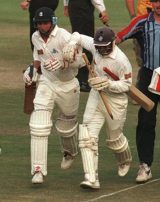Eleven moves that misfired
One of the talking points of the ongoing Mumbai Test will be Rahul Dravid's decision to field, on a pitch that has traditionally favoured teams batting first. Rob Smyth looks at 11 classic cock-ups, ranging from South Africa's number blunder to Nasser Hussain's Gabba shocker.
|
|

|
Number crunching, World Cup, 2002-03
Mark Boucher was the one with blood on his hands when South Africa crashed out of their own World Cup. With one run needed under Duckworth-Lewis to keep them ahead against Sri Lanka, he calmly played out a dot-ball. But several came under the blood curse: the coach and captain who misread the charts, 12th man Nicky Boje who gave Boucher wrong information, and of course mathematicians the world over.
Bouncing Patterson, Melbourne, 1988-89
The Melbourne Test: revelry, Christmas cheer, and death threats. Just before the close of the fourth day's play, Steve Waugh decided to bounce Patrick Patterson. He's had brighter ideas. At stumps Patterson rampaged into the Australian dressing-room and promised to kill them all out in the middle the next day. He didn't quite manage that, but, in a frenzied spell of 5 for 39, came uncomfortably close.
Dissing Ambrose, Sydney, 1992-93
Rags do not come any redder. Dean Jones always fancied himself as a bit of a matador but he got it badly wrong when in a World Series final he asked Curtly Ambrose to remove his white wristbands. "He was definitely trying some form of camouflage," Jones said. "I didn't think much of it at the time." Ambrose did. He took off his wristbands - then tore Australia asunder with 5 for 32.
|
|

|
Enforcing the follow-on, Kolkata, 2000-01
A tactic damned only by hindsight: with the possible exception of Mark Taylor, we would all have done what Steve Waugh did: India were at rock bottom; 1-0 down and 274 behind. Then came one of the most stunning comebacks in cricket history and, from being a shoo-in for that long-awaited win in India, it all fell apart for Australia. It was a wrong Waugh never got to right.
Going for the hundred, Johannesburg, 1995-96
Sometimes the box seat can get a bit too comfortable. South Africa were so preoccupied with Brian McMillan getting a century at Johannesburg in 1995 that they lost the plot. They could have given England six sessions and 10 overs to survive; instead they gave them five sessions and four overs. It was an indulgence - McMillan even came off for light - that ushered a ragged England away from the point of no return. For all 643 minutes of Mike Atherton's vigil, England never went near it again.
Playing the seamers, Calcutta, 1992-93
When in Rome, do as bloody-minded Englishmen. On a Calcutta dustbowl, England picked four seamers and just one spinner. Worse still, that spinner was Ian Salisbury (not in the original party) ahead of Phil Tufnell (the chosen matchwinner). The result? England were hammered, and Tufnell never recovered from the battering his confidence took: he came into the tour with four five-fors in 10 Tests; he took only one in his final 32.
|
|

|
Promoting the tail, Chandigarh, 1995-96
Victory was in sight: eight wickets left, 43 runs needed off 54 balls. But a World Cup semi-final does funny things to the brain, and Roger Harper and Otis Gibson, little more than glorified sloggers, were inexplicably promoted. Australia, smelling the fear, brushed them aside, then choked the proper batsmen. West Indies somehow lost by five runs; there was less panic in The Towering Inferno.
Goading Lillee, Brisbane, 1974-75
At the start of England's Ashes tour, Tony Greig staged a one-man campaign to get on Dennis Lillee's nerves. First he bounced him out - prompting Lillee to storm into the Australian dressing-room and announce: "Just remember who started this thing, but we'll finish it" - and then, in the course of a brilliant century, treated Lillee like a dog, constantly goading him ("That's four, fetch that") and cockily shadowboxing his bouncers. Greig could handle himself; England - battered, bruised and beaten by Lillee and Jeff Thomson - couldn't.
|
|

|
Forgetting Smith's name, Edgbaston, 2003
You suspect that nothing would have made Nasser Hussain happier than to wake up one morning, look in the mirror and see Steve Waugh staring back at him. In 2003, in a comically bungled attempt at Waugh-esque mind games, he called Graeme Smith "what's-his-name", and introduced him to the match referee as `Greg' at the toss for the first Test. It was condescending, and costly: Hussain, suddenly humbled, resigned as captain, and Smith scored 621 Test runs in the next nine days.
Going slow, Lord's, 1979
This was batting at its most cautious: Mike Brearley and Geoff Boycott went so slow in the World Cup final that England needed 158 off 22 overs when Brearley was out. Hard enough at the best of times, let alone while getting your eye in, and with Joel Garner's yorker spearing in from the heavens. The Big Bird stomped all over England with 5 for 4 in 11 balls and, 25 years on, England are no closer to winning a World Cup.
Putting Australia in, Brisbane, 2002-03
So close to the edge did Nasser Hussain reside during his gloriously emotive reign as England captain that there could be no half-measures - and this was an absolute shocker. The decision was bad, the logic behind it - to hopefully have Australia around 300 for 6 at the close - even worse. A classic example of compromising a strength to cover a weakness, and England's diabolical performance reflected the paralysing fear that had gripped the side.
This article was first published in the The Wisden Cricketer in August 2004.
Click here for further details.
